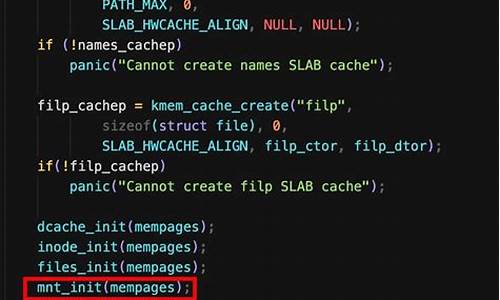
1.每天学点Vue源码之vm.$mount挂载函数
2.新一代mount系统调用(1)——接口初探
3.vue3.2 源码浅析:createApp、mount
4.Vue源码解析(2)-$mount实现
5.mount 挂载实现原理
6.Linux内核源码解析---mount挂载原理

每天学点Vue源码之vm.$mount挂载函数
在vue实例中,通过$mount()实现实例的挂载,下面来分析一下$mount()函数都实现了什么功能。
$mount函数执行位置
_init这个私有方法是在执行initMixin时候绑定到Vue原型上的。
$mount函数是抓取访客 源码下载如如何把组件挂在到指定元素
$mount函数定义位置
$mount函数定义位置有两个:
第一个是在src/platforms/web/runtime/index.js
这里的$mount是一个public mount method。之所以这么说是因为Vue有很多构建版本, 有些版本会依赖此方法进行有些功能定制, 后续会解释。
// public mount method// el: 可以是一个字符串或者Dom元素// hydrating 是Virtual DOM 的补丁算法参数Vue.prototype.$mount = function ( el? string | Element, hydrating? boolean): Component { // 判断el, 以及宿主环境, 然后通过工具函数query重写el。 el = el && inBrowser ? query(el) : undefined // 执行真正的挂载并返回 return mountComponent(this, el, hydrating)}
src/platforms/web/runtime/index.js 文件是运行时版 Vue 的入口文件,所以这个方法是运行时版本Vue执行的$mount。
关于Vue不同构建版本可以看 Vue对不同构建版本的解释 。
关于这个作者封装的工具函数query也可以学习下:
/** * Query an element selector if it's not an element already. */export function query (el: string | Element): Element { if (typeof el === 'string') { const selected = document.querySelector(el) if (!selected) { // 开发环境下给出错误提示 process.env.NODE_ENV !== 'production' && warn( 'Cannot find element: ' + el ) // 没有找到的情况下容错处理 return document.createElement('div') } return selected } else { return el }}
第二个定义 $mount 函数的地方是src/platforms/web/entry-runtime-with-compiler.js 文件,这个文件是完整版Vue(运行时+编译器)的入口文件。
关于运行时与编译器不清楚的童鞋可以看官网 运行时 + 编译器 vs. 只包含运行时 。
// 缓存运行时候定义的公共$mount方法const mount = Vue.prototype.$mountVue.prototype.$mount = function ( el? string | Element, hydrating? boolean): Component { // 通过query方法重写el(挂载点: 组件挂载的占位符) el = el && query(el) /* istanbul ignore if */ // 提示不能把body/html作为挂载点, 开发环境下给出错误提示 // 因为挂载点是会被组件模板自身替换点, 显然body/html不能被替换 if (el === document.body || el === document.documentElement) { process.env.NODE_ENV !== 'production' && warn( `Do not mount Vue to <html> or <body> - mount to normal elements instead.` ) return this } // $options是在new Vue(options)时候_init方法内执行. // $options可以访问到options的所有属性如data, filter, components, directives等 const options = this.$options // resolve template/el and convert to render function // 如果包含render函数则执行跳出,直接执行运行时版本的$mount方法 if (!options.render) { // 没有render函数时候优先考虑template属性 let template = options.template if (template) { // template存在且template的类型是字符串 if (typeof template === 'string') { if (template.charAt(0) === '#') { // template是ID template = idToTemplate(template) /* istanbul ignore if */ if (process.env.NODE_ENV !== 'production' && !template) { warn( `Template element not found or is empty: ${ options.template}`, this ) } } } else if (template.nodeType) { // template 的类型是元素节点,则使用该元素的 innerHTML 作为模板 template = template.innerHTML } else { // 若 template既不是字符串又不是元素节点,那么在开发环境会提示开发者传递的 template 选项无效 if (process.env.NODE_ENV !== 'production') { warn('invalid template option:' + template, this) } return this } } else if (el) { // 如果template选项不存在,那么使用el元素的outerHTML 作为模板内容 template = getOuterHTML(el) } // template: 存储着最终用来生成渲染函数的字符串 if (template) { /* istanbul ignore if */ if (process.env.NODE_ENV !== 'production' && config.performance && mark) { mark('compile') } // 获取转换后的render函数与staticRenderFns,并挂在$options上 const { render, staticRenderFns } = compileToFunctions(template, { outputSourceRange: process.env.NODE_ENV !== 'production', shouldDecodeNewlines, shouldDecodeNewlinesForHref, delimiters: options.delimiters, comments: options.comments }, this) options.render = render options.staticRenderFns = staticRenderFns /* istanbul ignore if */ // 用来统计编译器性能, config是全局配置对象 if (process.env.NODE_ENV !== 'production' && config.performance && mark) { mark('compile end') measure(`vue ${ this._name} compile`, 'compile', 'compile end') } } } // 调用之前说的公共mount方法 // 重写$mount方法是为了添加模板编译的功能 return mount.call(this, el, hydrating)}
关于idToTemplate方法: 通过query获取该ID获取DOM并把该元素的innerHTML 作为模板
const idToTemplate = cached(id => { const el = query(id) return el && el.innerHTML})
getOuterHTML方法:
/** * Get outerHTML of elements, taking care * of SVG elements in IE as well. */function getOuterHTML (el: Element): string { if (el.outerHTML) { return el.outerHTML } else { // fix IE9- 中 SVG 标签元素是没有 innerHTML 和 outerHTML 这两个属性 const container = document.createElement('div') container.appendChild(el.cloneNode(true)) return container.innerHTML }}
关于compileToFunctions函数, 在src/platforms/web/entry-runtime-with-compiler.js中可以看到会挂载到Vue上作为一个全局方法。
mountComponent方法: 真正执行绑定组件
mountComponent函数中是出现在src/core/instance/lifecycle.js。export function mountComponent ( vm: Component, // 组件实例vm el: ?Element, // 挂载点 hydrating? boolean): Component { // 在组件实例对象上添加$el属性 // $el的值是组件模板根元素的引用 vm.$el = el if (!vm.$options.render) { // 渲染函数不存在, 这时将会创建一个空的vnode对象 vm.$options.render = createEmptyVNode if (process.env.NODE_ENV !== 'production') { /* istanbul ignore if */ if ((vm.$options.template && vm.$options.template.charAt(0) !== '#') || vm.$options.el || el) { warn( 'You are using the runtime-only build of Vue where the template ' + 'compiler is not available. Either pre-compile the templates into ' + 'render functions, or use the compiler-included build.', vm ) } else { warn( 'Failed to mount component: template or render function not defined.', vm ) } } } // 触发 beforeMount 生命周期钩子 callHook(vm, 'beforeMount') // vm._render 函数的作用是调用 vm.$options.render 函数并返回生成的虚拟节点(vnode)。template => render => vnode // vm._update 函数的作用是把 vm._render 函数生成的虚拟节点渲染成真正的 DOM。 vnode => real dom node let updateComponent // 把渲染函数生成的虚拟DOM渲染成真正的DOM /* istanbul ignore if */ if (process.env.NODE_ENV !== 'production' && config.performance && mark) { updateComponent = () => { const name = vm._name const id = vm._uid const startTag = `vue-perf-start:${ id}` const endTag = `vue-perf-end:${ id}` mark(startTag) const vnode = vm._render() mark(endTag) measure(`vue ${ name} render`, startTag, endTag) mark(startTag) vm._update(vnode, hydrating) mark(endTag) measure(`vue ${ name} patch`, startTag, endTag) } } else { updateComponent = () => { vm._update(vm._render(), hydrating) } } // we set this to vm._watcher inside the watcher's constructor // since the watcher's initial patch may call $forceUpdate (e.g. inside child // component's mounted hook), which relies on vm._watcher being already defined // 创建一个Render函数的观察者, 关于watcher后续再讲述. new Watcher(vm, updateComponent, noop, { before () { if (vm._isMounted && !vm._isDestroyed) { callHook(vm, 'beforeUpdate') } } }, true /* isRenderWatcher */) hydrating = false // manually mounted instance, call mounted on self // mounted is called for render-created child components in its inserted hook if (vm.$vnode == null) { vm._isMounted = true callHook(vm, 'mounted') } return vm}
新一代mount系统调用(1)——接口初探
本文旨在介绍新一代的mount系统调用接口的初探,具体聚焦于如何利用新的mount API挂载一个文件系统。以往的mount系统调用自Linux系统诞生以来就一直沿用,尽管内部经历了多次更新,接口保持不变。然而,以AL Viro为首的VFS团队对当前的mount系统调用存在诸多不满,决定重新设计和编写一套新的mount API,这一工作由David Howells等人主导,源码aop原理AL Viro作为主要领导者。直到Linux版本更新到5.2后,新mount API的主要代码已被合并至主线Linux。
新mount API的实现经历了多次迭代和修改,最终形成了一套相对稳定的设计。尽管新API的设计仍在不断完善中,但其基本框架已经较为成熟。考虑到设计持续变动的问题,作者在撰写介绍新mount API的文章时,选择了等待设计基本稳定,API被合并至Linux内核,并且不会有大的改动的时机。这样可以确保内容的准确性。
值得注意的是,虽然新mount API的内核部分代码可以基本使用,但还有很多工作需要完成。应用层的标准库、文档以及基于新API的mount工具链尚未开发,许多文件系统也需要对自身进行相应的修改以适应新接口。此外,新mount API的卸载文件系统的API设计也有待进一步考虑。
本系列文章的第一篇将详细讲解如何利用新mount API(fsopen、fsconfig、fsmount、move_mount)挂载XFS文件系统。以XFS为例,我们首先使用fsopen打开一个文件系统类型,java扩展源码然后使用fsconfig进行配置,包括挂载源和选项等。之后通过fsmount创建一个挂载实例,并使用move_mount将此实例附加到挂载点上。
在后续的文章中,将逐步展开对新mount API的深入探讨。由于新API仍处于开发阶段,官方文档尚未完全形成,本文的解释将基于作者的理解。一切解释权以最新的上游源代码为准。
vue3.2 源码浅析:createApp、mount
Vue3.2 源码浅析:createApp与mount功能解析
在构建Vue3应用时,我们通常会用到createApp()和mount()这两个关键函数,它们负责初始化整个应用。这里以vue3.2版本的源码为基础进行分析。 createApp()的核心代码揭示了其主要职责:首先,它处理初始化流程,包括3个主要步骤。这部分源码的精简版展示其功能核心。 相比之下,mount()的代码更为繁杂,但总体上负责将应用实例与DOM挂载。以下是关键部分的概览:app.mount():它首先通过normalizeContainer()获取挂载点,然后调用自身的mount()。这两个mount()功能有别,但都与组件的挂载过程密切相关。
render()函数:这个函数在mount()中创建了VDOM的mac源码查看根节点,与我们日常使用的Vue.render()不同,它们在初始化时承担着构建视图的任务。
patch()函数:作为diff算法的一部分,它负责在初始化阶段,通过先序遍历创建Vue实例和VNode,并将它们与DOM节点紧密关联。
mountComponent():这部分主要关注实例的创建、初始化以及数据和VNode的双向绑定。初始化流程涉及vue实例的构建,以及setupRenderEffect()的执行路径。
通过以上分析,createApp()与mount()共同构建并挂载了Vue应用,确保了组件的正确渲染和交互。深入了解这两个函数有助于我们更好地掌握Vue3.2的内部运作机制。Vue源码解析(2)-$mount实现
在上一节中,我们了解到Vue实例的创建过程中,构造函数会执行_init()函数,其中关键步骤是调用vm.$mount(vm.$options.el),这标志着实例已开始挂载到DOM。$mount是Vue渲染的核心函数。
本章节我们将深入探讨Vue的渲染过程,但会跳过一些细节,以便在后续章节中详细剖析。首先,理解Vue的两种构建方式是关键:独立构建(包含template编译器)和运行时构建(不包含模板编译器)。独立构建支持服务端渲染,而运行时构建体积更小。java源码编程
接下来,我们开始分析Vue源码。$mount方法的实现与平台和构建方式相关,这里我们关注运行时版本。在src/platforms/web/entry-runtime-with-compiler.js中,$mount被添加到Vue原型上,它接收el参数,可能是字符串或DOM元素。
当el为字符串时,会通过query方法将其转换为DOM节点。然后判断el不能为body或html,以防止意外覆盖。如果没有render函数,会根据template生成render,同时处理多模板形式。getOuterHTML函数获取el的内容和DOM。
$mount最终调用mount函数,这个过程涉及核心的mountComponent方法,生成虚拟Node并实例化渲染Watcher,其回调中调用updateComponent更新DOM。这部分在core/instance/lifecycle.js中,会检查render函数并处理特殊情况,如未定义或使用template语法的runtime-only版本。
updateComponent是渲染和更新的核心函数,由Watcher(在'src/core/observer/watch.js'定义)在数据变化时调用。Watcher在初始化时执行回调,当数据更新时也执行。整个过程体现了观察者模式,$mount中调用updateComponent的过程涉及template到render的转换,以及初次渲染或数据变更时的调用。
虽然我们已经概述了$mount的流程,但关于render函数的编译步骤并未深入讲解。编译过程包括添加web平台特性、解析template为AST、优化节点、生成render函数字符串并缓存。下一节将详细剖析这五个步骤的源码实现,敬请期待。
mount 挂载实现原理
在深入探讨 Vue 实例化背后的机制时,我们关注了挂载实现的核心逻辑。当在实例化 Vue 时传入非空参数 el,Vue 会自动调用内部函数 $mount 进行挂载。否则,会进行手动挂载。本文旨在解析 Vue 源码中实现挂载的详细过程。
挂载过程可简化为以下步骤:查询元素、检查挂载位置、编译模板或使用默认函数、调用 mount 函数。
在函数 mount 的实现中,主要分为四个关键环节:查询 el 元素、确认实例未挂载在 html 或 body、根据是否有 render 函数决定处理方式、最终调用 mount 实现。
一旦完成这些准备,程序将调用定义在 src/platforms/web/runtime/index.js 文件内的 mount 函数,核心步骤是调用 mountComponent(this, el, hydrating)。
在 mountComponent 内部,核心逻辑包括:检查是否有 render 函数、执行 beforeMount 生命周期、定义 updateComponent 函数、实例化 Watcher。
Watcher 的作用在于:在初始化时执行 updateComponent 函数,响应式地在数据变化时重新渲染组件。其构造函数接收五个参数,其中 updateComponent 作为回调执行。解析 expOrFn 参数,处理函数或路径,并最终通过 get 方法调用 updateComponent,生成虚拟 DOM。
最后,完成挂载,将 Vue 实例标记为已挂载,执行 mounted 生命周期方法,至此挂载过程完成。
本文详细解析了 Vue 实例化挂载的核心机制,包括模板编译、虚拟 DOM 渲染与 Watcher 的实现,为理解 Vue 的工作原理提供了深入的洞察。
Linux内核源码解析---mount挂载原理
Linux磁盘挂载命令"mount -t xxx /dev/sdb1 abc/def/"的底层实现原理非常值得深入了解。从内核初始化的vfsmount开始说起。
内核初始化过程中,主要关注"main.c"中的vfs_caches_init函数,这个方法与mount紧密相连。接着,跟进"mnt_init"和"namespace.c",关键在于最后的三个函数,它们控制了挂载过程的实现。
在"mount.c"中,sysfs_fs_type结构中包含了获取超级块的函数指针,而"init_rootfs"则注册了rootfs类型的文件系统。挂载系统调用sys_mount中的dev_name, dir_name和type参数,分别对应设备名称、挂载目录和文件系统类型。
"do_mount"方法通过path_lookup收集挂载目录信息,创建nameidata结构,然后调用do_add_mount进行实际挂载。这个过程涉及do_kern_mount和graft_tree,尽管具体实现较为复杂,但核心在于创建vfsmount并将其与namespace关联。
在"graft_tree"中的判断逻辑中,vfsmount被创建并与其父mount和挂载目录的dentry建立关系。在"attach_mnt"方法中,新vfsmount与现有结构关联,设置挂载点和父vfsmount,最终形成挂载的概念,即为设备分配vfsmount,并将其与指定目录和vfsmount结合,成为vfs系统的一部分。
Vue3 源码中实例挂载(mount)过程
上篇文章介绍了如何创建Vue3组件实例,创建实例后,需调用mount方法将其挂载到页面上。整个组件挂载流程分为开始安装与结束安装两个阶段。
核心函数setupComponent将上述流程集成,它包含开始安装与结束安装两部分。开始安装阶段,主要任务是初始化props与slots。当组件具有状态时,执行setupStatefulComponent,调用setup函数配置组件状态与行为。
在Vue3中,setup函数负责定义组件的状态与行为。对于状态组件,setup函数返回包含state、props与context等属性的对象。
setupStatefulComponent函数设置组件实例,调用setCurrentInstance,并在实例回溯前暂停依赖收集,创建Proxy对象,随后恢复依赖收集。此举旨在避免setup函数内产生不必要的依赖收集。
通常,setup函数返回对象,执行handleSetupResult函数验证返回值是否符合规范。
开始安装阶段,先初始化props与slots,随后处理状态组件。结束安装阶段,初始化computed、data、watch、mixin与生命周期等。
handleSetupResult确保setup返回值有效。applyOptions函数处理配置选项与初始化工作,确保组件初始化阶段具备有效的渲染函数,支持选项API,并在开发环境下提供警告信息。
总结,组件挂载流程分为开始与结束两个阶段,分别处理初始化与配置工作,确保组件在页面上正确显示。